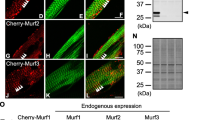Abstract
The myosin heavy chain (MHC)-based fibre composition of adult rat adductor magnus (AM) and tibialis anterior (TA) muscles was investigated using single fibre analysis. Microelectrophoresis performed on single fibre fragments demonstrated a predominance of pure fast MHC-based fibre types (expressing only one fast MHC). Most of the fibres analysed from both the AM (72%) and TA (50%) were pure type IIB (expressing only MHCIIb). Pure type IID fibres (expressing only MHCIId) were also abundant in AM (20%) and TA (18%). In addition, hybrid fibres coexpressing MHCIIb and MHCIId in varying proportions (fibre types IIBD and IIDB) were found, as well as fibres coexpressing MHCIId and MHCIIa with a predominance of MHCIId (type IIDA) and some C fibres (coexpressing MHCI and MHCIIa in varying proportions). Considered altogether, these data reflect the dynamic nature of adult skeletal muscle fibres and indicate a continuum of MHC-based fibre types in normal rat muscle with transitions in the order IIB ↔ IIBD ↔ IIDB ↔ IID ↔ IIDA ↔ IIAD ↔ IIA ↔ IIC ↔ IC ↔ I.
Similar content being viewed by others
References
Aigner S, Gohlsch B, Hämäläinen N, Staron RS, Uber A, Wehrle U, Pette D (1993) Fast myosin heavy chain diversity in skeletal muscles of the rabbit: heavy chain IId, not IIb predominates. Eur J Biochem 211:367–372
Bär A, Pette D (1988) Three fast myosin heavy chains in adult rat skeletal muscle. FEBS Lett 235:153–155
Brooke MH, Kaiser KK (1970) Three myosin adenosine triphosphatase systems: the nature of their pH lability and sulfhydryl dependence. J Histochem Cytochem 18:670–672
Füchtbauer E-M, Rowlerson AM, Götz K, Friedrich G, Mabuchi K, Gergely J, Jockusch H (1991) Direct correlation of parvalbumin levels with myosin isoforms and succinate dehydrogenase activity on frozen sections of rodent muscle. J Histochem Cytochem 39:355–361
Gorza L (1990) Identification of a novel type 2 fiber population in mammalian skeletal muscle by combined use of histochemical myosin ATPase and anti-myosin monoclonal antibodies. J Histochem Cytochem 38:257–265
Guth L, Samaha FJ (1969) Qualitative differences between actomyosin ATPase of slow and fast mammalian muscle. Exp Neurol 25:138–152
Hämäläinen N, Pette D (1993) The histochemical profiles of fast fiber types IIB, IID and IIA in skeletal muscles of mouse, rat and rabbit. J Histochem Cytochem 41:733–743
Kirschbaum BJ, Schneider S, Izumo S, Mahdavi V, Nadal-Ginard B, Pette D (1990) Rapid and reversible changes in myosin heavy chain expression in response to increased neuromuscular activity of rat fast-twitch muscle. FEBS Lett 268:75–78
Oakley BR, Kirsch DR, Morris NR (1980) A simplified ultrasensitive silver stain for detecting proteins in polyacrylamide gels. Anal Biochem 105:361–363
Parry DJ, Zardini D (1990) Characterization of IIx fibres in mouse muscles. In: Pette D (ed) The dynamic state of muscle fibers. de Gruyter, Berlin New York, pp 343–354
Pette D, Spamer C (1986) Metabolic properties of muscle fibers. Fed Proc 45:2910–2914
Pette D, Staron RS (1990) Cellular and molecular diversities of mammalian skeletal muscle fibers. Rev Physiol Biochem Pharmacol 116:1–76
Schiaffino S, Saggin L, Viel A, Gorza L (1985) Differentiation of fibre types in rat skeletal muscle visualized with monoclonal antimyosin antibodies. J Muscle Res Cell Motil 6:60–61
Schiaffino S, Saggin L, Viel A, Ausoni S, Sartore S, Gorza L (1986) Muscle fiber types identified by monoclonal antibodies to myosin heavy chains. In: Benzi G, Packer L, Siliprandi N (eds) Biochemical aspects of physical exercise. Elsevier, Amsterdam New York, pp 27–34
Staron RS, Pette D (1986) Correlation between myofibrillar ATP-ase activity and myosin heavy chain composition in rabbit muscle fibers. Histochemistry 86:19–23
Termin A, Pette D (1992) Changes in myosin heavy-chain isoform synthesis of chronically stimulated rat fast-twitch muscle. Eur J Biochem 204:569–573
Termin A, Staron RS, Pette D (1989a) Myosin heavy chain isoforms in histochemically defined fiber types of rat muscle. Histochemistry 92:453–457
Termin A, Staron RS, Pette D (1989b) Changes in myosin heavy chain isoforms during chronic low-frequency stimulation of rat fast hindlimb muscles — A single fiber study. Eur J Biochem 186:749–754
Wada M, Pette D (1993) Relationships between alkali light chain complement and myosin heavy chain isoforms in single fast-twitch fibers of rat and rabbit. Eur J Biochem 214:157–161
Author information
Authors and Affiliations
Rights and permissions
About this article
Cite this article
Staron, R.S., Pette, D. The continuum of pure and hybrid myosin heavy chain-based fibre types in rat skeletal muscle. Histochemistry 100, 149–153 (1993). https://doi.org/10.1007/BF00572901
Accepted:
Issue Date:
DOI: https://doi.org/10.1007/BF00572901




